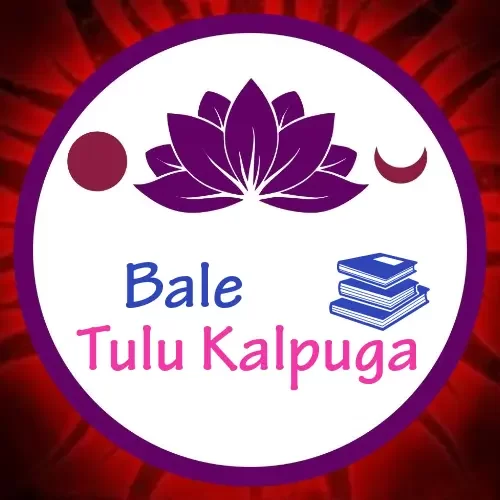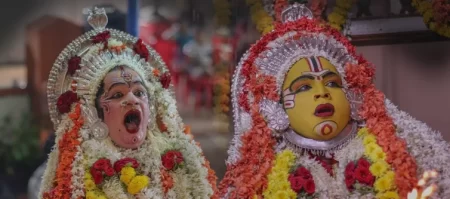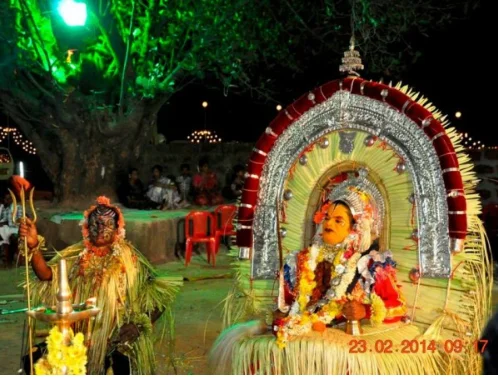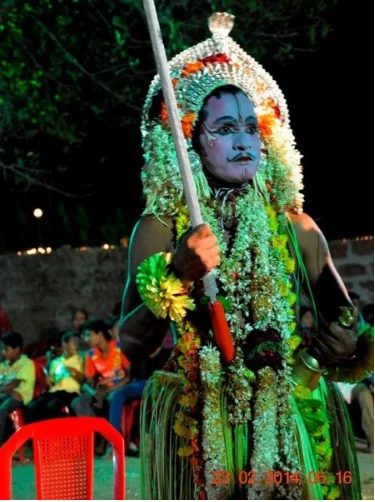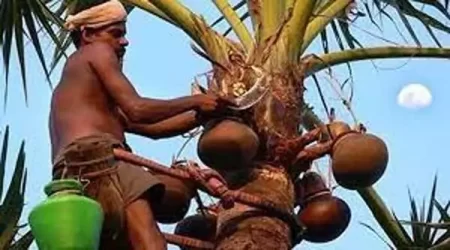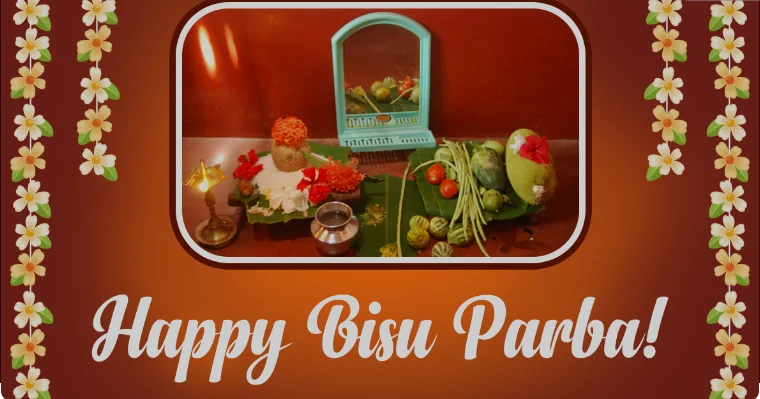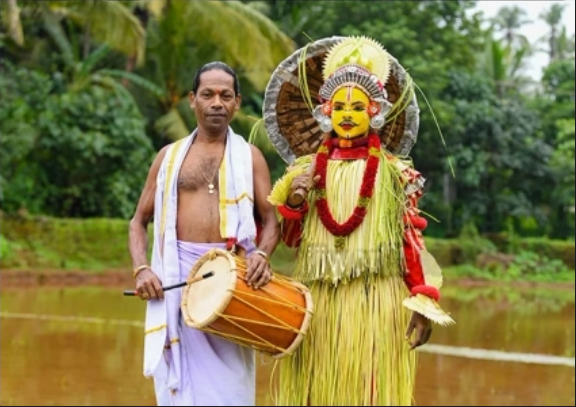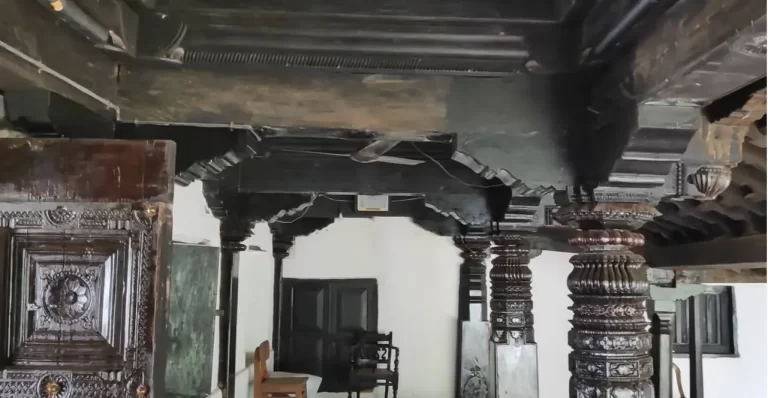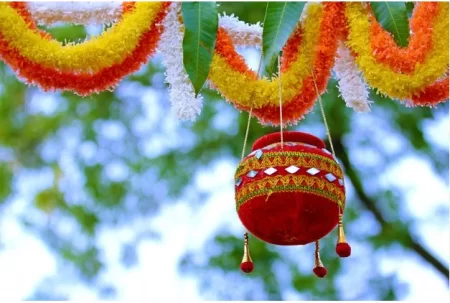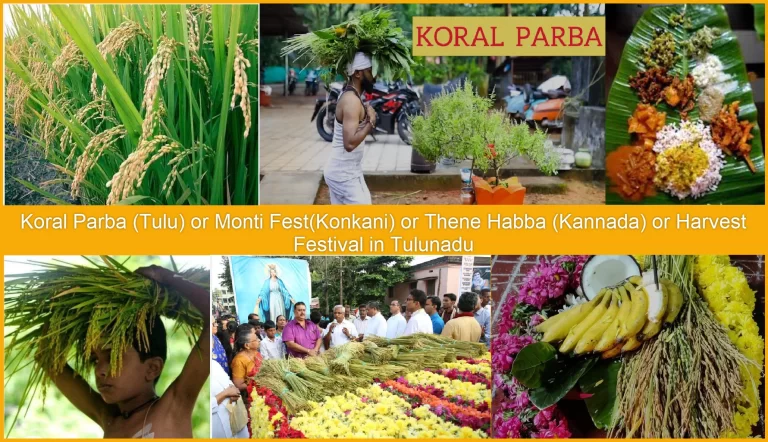Bhootha Aradhane
Bhootha Kola
India is a host for a variety of ethnicity, customs, and practices and all these have variations among themselves from region to region. Many of the customs stay hidden from the main hinterland and with growing urbanization and migration of people into urban settlements, these smaller than usual environments are starting to disappear or getting kept to little pockets with no space to exhibit or give them to people in the future. India’s Identity has been the social legacy and such moment customs and ethnic practices which have prompted her huge history and progress in the field of workmanship, dance, development, and food.
The preservation, rejuvenation, or connecting folk art to the mainstream has been in insurgence within the country in the recent past. From Bamboo craftsmanship of the northeast to Kathakali from Kerela, providing a plethora of folk styles has been brought to the forefront. These initiatives have also led to an increase in people traveling to such destinations out of curiosity, marvel and the thrill of explorations increasing tourist and business opportunities.
The inspiration to feature the social legacy and customs of a district has finished in making a visual item to introduce or publicize the southern waterfront area of Karnataka, locally called Tulunadu through methods for creating a part of that locale that is profoundly established in the way of life of that area related with ceremonial dance ritual for their deities called as Bhootha Aradhane.
The Folk Ritual – Bhootha Kola
Centuries old tradition from earlier Indian civilization; Sheer belief in spirits and ancestors; worship contrasting with African tribes; celebration influenced by many ethnic and cultural groups but still survives and much more will be presented in this article.
The act of Bhootha worship is an exclusive instance within the Tulunadu region comprising Udupi and Mangalore districts of Karnataka and Kasargod district of Kerala. The Kola or Nema is night long ritual characterized by the invocation, possession of the Daivas through an impersonator, and conversation with the local deities to sort out the difficulties pertaining to the village or town through its guidance.
Tulunadu
Tulunadu is a region on the southwestern coast of India characterized by a common language spoken among the people of the region, Tulu. Dakshin Kannada, Udupi, and Kasargod belong to this place. This region, sandwiched between the Arabian sea and western ghats and mainly dependent on agriculture and fishing have lush paddy fields and plantations of coconut, areca nut, and cashew provides an indigenous culture and traditions shifting away from the mainstream worship rituals of the Indian subcontinent. One such tradition is the worship of holy spirits and the ritual associated with it called Bhootha or Daiva Aaradhane
The Guardian Spirits: Bhootha/Daiva
Bhoothas or Daivas are semi-divine spirits distinct from people and Gods. The term Bhootha supposedly is gotten from the Sanskrit root bhu-, to become, from which determines the participle structure bhootha, implying ‘what has existed’. Bhoothas, then, at that point, are the spirits of past heroes/heroines or champions, who finished brave deeds and accomplished affliction before. Some bhootha are gotten from animist roots and some are joined from Vedic fanciful figures and numerous as familial spirits. Daivas are considered as startling and dangerous figures, related with the wild, whom only people with justice in mind simply have no compelling reason to fear. On the off chance that the bhootha is fulfilled, things are as they ought to be; yet when criticism is made, it isn’t to be messed with. It is this origination of the Bhoothas equity that legitimizes Bhootha Aaradhane’s ability for following up on social relations within that ecosystem.
Origin of Bhootha
The origins of Bhootas and its worship in the region of Tulu Nadu and few parts of Kerala are very ambiguous and unclear. Though there are theories based on the practices and association of these Bhoothas which provides a few inferences. Some attribute the worship of Bhoothas or Daivas to the ancient nature worship practiced by early humans. This is obvious from the earliest sacred texts, Rig Veda, where the divinities were nature-based like Agni, Indra, Prithvi, and so forth As periods went on, aside from adoring the fundamental components of nature, they respected and revered their dead local area pioneers and legends who were thought to exist as spirits or spirits even after their demise. Networks and settlements came around horticultural practices thus likewise the risks to edit items and cows through wild creatures. Harvests and dairy cattle get eaten up by pigs and tigers and the danger of snakes arose considerably more. Henceforth, the man started venerating the soul of Tigers and hogs arguing security to his life and harvests. Such antiquated convictions and religions later prompted the way of life of revering Spirits (Bhoota/Daiva) and later advanced into the worship of Gods that eventually showed in various as well as single structures as per philosophies glided once in a while.
Bhootha Rituals and Practices
The custom of Nema begins when the date of the Nema is chosen dependent on the nakshatras. When the dates have been concluded, it is told to Patri or impersonator who follows a severe arrangement of purging and sanitizing himself to turn into a vassal for Daiva. Arrangements: Early in the evening, Bhandara or the equipment of Bhoota is removed from the shrine and kept at the ritual site, which is finished with blossoms and plantain leaves. On the off chance that the Bhoota is a Kutumba Daiva or family divinity, Bhandara would be removed from the room in Tharavadu House(First Home) where the gear of the Bhutha would have been kept. The custom site contains a special altar and it is a nook framed by coconut palm leaves and delicate banana plants. Bhandara of Bhoota comprises metal veils, blades, pikes, Chaamara(hand-held fan), and bell. A few groups are associated with the making of Siri or Chiri(skirt made of delicate palm leaves) and Ani, a semi-roundabout construction containing silver curves, bamboo sticks, and fabric. Ani is enhanced with blossoms and is attached to the rear of the entertainer of Kola.
Yenne Boolya:
– Ynne-Veelya (in Kannada) – Kola entertainer or village chief is given a conventional greeting from the coordinators to play out the Kola by giving Yenne Boolya (Yenne-Veelya). Yenne Boolya comprises coconut oil, betel nut, and betel leaves. The Kola entertainer is given a stately oil shower after Yenne Boolya to sanitize his body and to resist the urge to panic. After the oil shower, the entertainer spellbinds himself by performing theatrics helped by uproarious music. Wearing a Mundu or Panche, Patri bents a steel plate by more than once hitting it with his head. Then, at that point entertainers run angrily unruly at the spot of execution pushing assembled individuals, attempting to leave the spot. Individuals assembled to see the Kola attempt to placate them by not allowing him to leave the spot and push him in. At a corner, few individuals will be available holding pots filled with water. When the entertainers arrive at that corner, water is poured on the entertainers denoting a finish to the theatrics.
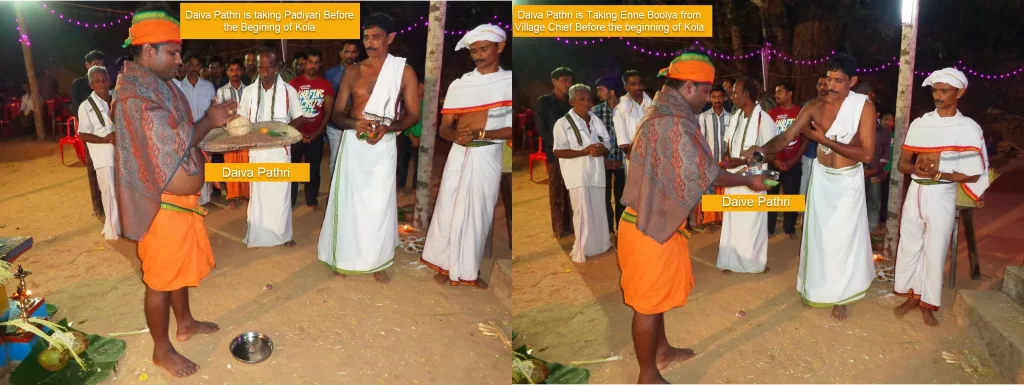
Aradale (Make-Up)
: Elaborate makeup and costume is an important step of Kola. Firstly, the performers put on make-up with their faces painted predominantly yellow. Eyebrows are painted in black. The forehead is marked with designs in black and red color. The distinctive yellow color comes from the bark of a tree called Aradale from which this process name has been derived. Face color may change based on the temperament of specific bhoota, if he is vindictive and with a high temper, he’ll be shown with the black colored face otherwise yellow. Costumes are mainly red in color with frills and shiny straps all over. If Bhoota or Daiva is female or transgender, he’ll be represented with a saree with colors according to tradition and diction. Headgear called Muga is placed and decorated with jasmine and firecracker flower representing purity and divine.
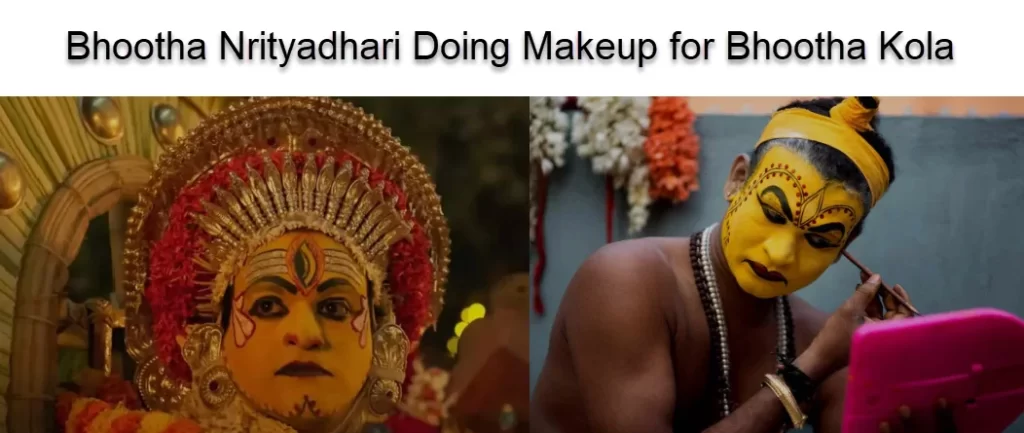
Bhoota Kunita( Daiva’s Dance)
Gaggara is a snake hood-shaped anklet with bells in it is used during the ritualistic dance to create a rhythm with the music. Wearing Gaggara(anklets), the Patri dance to the boisterous music.
In the picture above, Panjurli is showing Gaggara to the crowd. Gaggara is an ornament which is worn around the ankles in the legs. Before beginning, the Gaggara- the round ornament is taken out by the performer and he pays respect by taking Gaggara close to his heart.
Drums and shehnai are utilized to make an enchanting presentation with music. After a while, the entertainers put on a Siri or Chiri(skirt made of delicate palm leaves) and proceed with the dance. Then, at that point, individuals garland the Daiva. Garlands are removed by the Patri during the incensing showcase of feelings while performing Bhuta Kunita(dance of deities). Patri is then accompanied by two people holding fire lights to make pradakshinas(circumambulations) around the hallowed place. From that point forward, the Daiva is tied to the Ani onto his back and wooden construction with a skirt-like outfit made of beautiful garments is tied around his midriff. Metal veils of the Bhoota and a metal plastron are then put on. Kola gets more dramatic after that. For some time, the invoker of the Daiva is given two fire lights made of dry coconut palm leaves. Holding the fire lights in two hands, the invoker makes fine, delicate moves while moving. Since the outfit that he is currently wearing is substantial to the point that the prior lightning dance steps are absent. In a little while, the invoker is holding a blade in his right hand. Chaamara(hand-held fan made of hidinglike material) is snared onto one of the right fingers and a bell is held in the left hand. A drawn-out dance execution with better advances starts now. Confronting the alter, the Patri holds the sword high as a characteristic of regard to the heavenly soul during the presentation, ringing the bell held. This entire dynamic visual scene holds the crowd entranced in admiration
A trained individual who is thought to have momentarily transformed into a god himself performs Bhootada Kola. The performer has an aggressive demeanor, dances with ferocity, and engages in numerous rituals. This entertainer is feared and revered in the neighborhoods and is thought to provide solutions to people’s concerns on behalf of the deity. The dance and pooja procedures are accompanied by drumming and music. During Bhootada Kola, the community prays collectively in order to ask God for blessings, prosperity, and relief from the different issues that the community is facing.
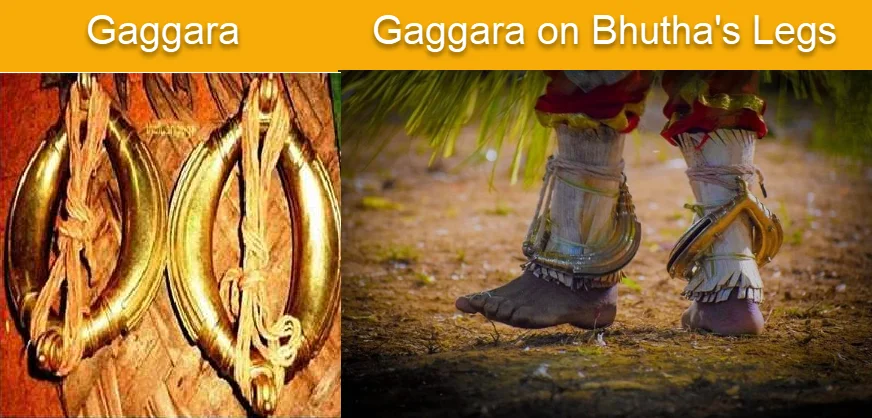
Food:
To satisfy the bhoota, puffed rice, and bananas, and chicken is provided to them as offerings. Tender coconut is given to quench his thirst and to replenish lost nutrients. Once everything is devoured that the Bhoota gets satisfied and proceeds to listen to his subject’s plights and grievance.
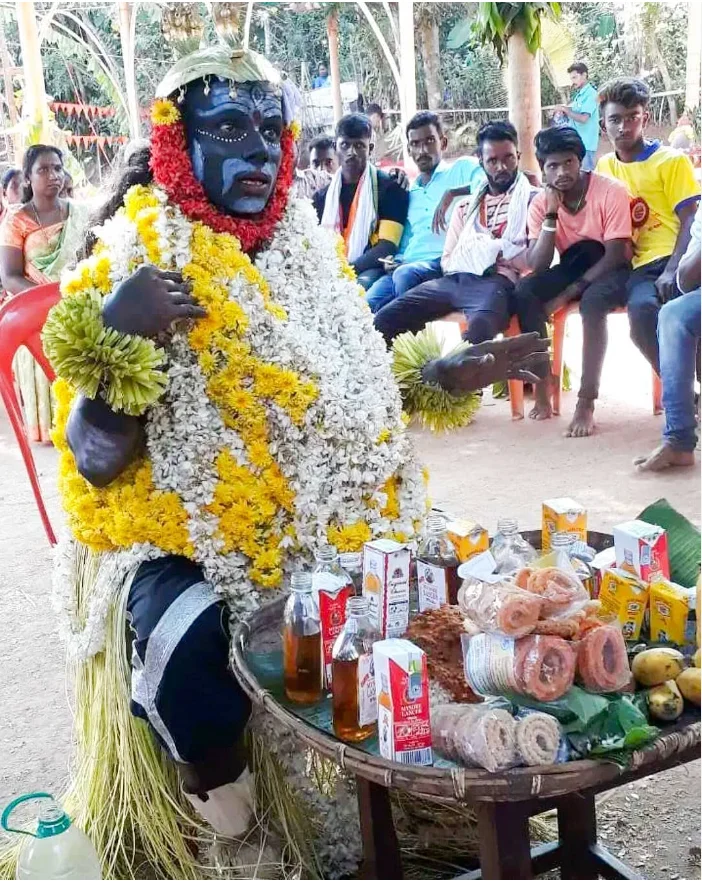
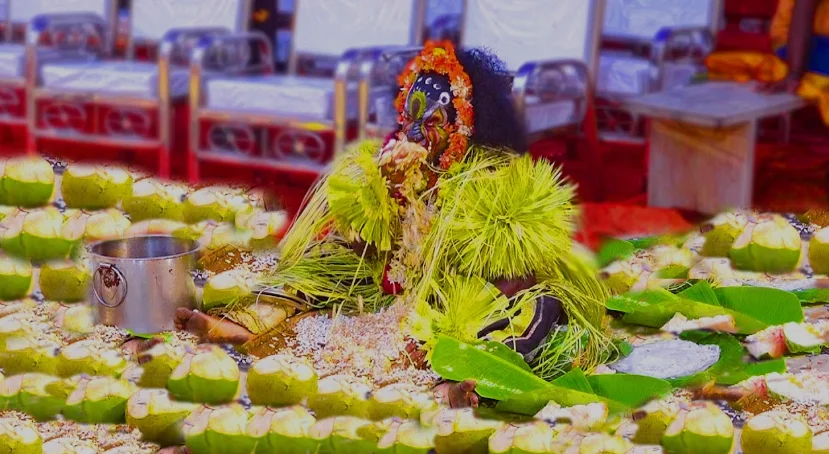
Aesthetics
Indian hypotheses of aesthetics appear to have a crowd-centered hypothesis of stylish experience. While entertainers are imperative to pass on the feeling of style as per Indian speculations of style and theater, the set, and the setting is likewise essential to improve the states of mind of the crowd. the Patri’s own highlights and structure are stifled by the intricate outfits, makeup, and objects of the kola. A definitive responsibility for experience is reliant upon the consideration that an onlooker provides for the exhibition and the setting, permitting them to make tasteful decisions. While the actual custom is implanted inside socio-strict practices, its tasteful experience is frequently expressed by individuals at two levels. At one level, the tangible style is handily recognized by most observers watching the custom. The new onlookers may get a handle on the loftiness of the custom however those acquainted with it will in general look past the glory and focus on the request for a custom, the oral presentations, and the pieces of the custom identified with the power of ownership. The observers acquainted with the custom may likewise assume the part of power (or specialists) to pass judgment on the accuracy of the custom, utilizing the two faculties and representative significance to all in all appreciate the custom of the Bhoota Kola. Most decisions depend on the memory of a past encounter with the Nema. First-time spectators will in general watch the Kola like a spectacle. One can’t recognize the different parts of the custom, its importance, or even the specific viewable signs that give the character of the bhoota in such a method of spectatorship. In the second level of the commitment, the onlooker submerges herself in the presentation. Such a submersion leads to what individuals allude to as a devotional state or “transcendental high” where they feel outwardly experience and renders them to see the world of the Bhootas.
Social Justice in Tulunadu
Social Structure of Nema
In ancient times, the Nema/Kola was the focal event on which the heads of Tulunadu showed and restored their force. Be that as it may, in contemporary occasions, the custom remaining parts significant however the organizations of force in which it is inserted have changed extraordinarily. Today, the families which stage the Nema are basically landholders, their properties much decreased via land changes. Despite the fact that the caste framework has been abolished in this country, the custom and the jobs are still intensely impacted by the position framework. Today, in a democratic-based arrangement of administration, medieval pecking orders at this point don’t exist, thus the previous decision families at this point don’t hold political or
legal office. All things considered, the townspeople request that they support their yearly Bhoota-Kola to respect the town’s divinity.
By organizing the Kola, the house head tries to emblematically announce himself as the authentic head of the local area. The residents offer Seva (deliberate assistance) during the celebration and in doing as such, additionally, offer their help to the Nema and acknowledgment of the pioneer’s status. Consequently, the townspeople expect equity and goal of debates by the Bhoota. The medium through which the Daiva connects with the townspeople is by having a person(male) called Patri. The Patri’s are from the scheduled caste of Nalike, Parava, or Pambadha people group According to regular conviction, some other normal individual can’t bear ownership by the soul and would die immediately whenever had. The most in simple and honest ranks were picked to be soul impersonators. This is on the grounds that, in past days, the heavenly soul used to control equity and address relational and town questions.
Having a simple and innocent as a Patri would yield certifiable predictions and would take out any doubt of treachery, boosting the certainty of individuals in the equity and arrangements offered by the Spirit or Daiva.
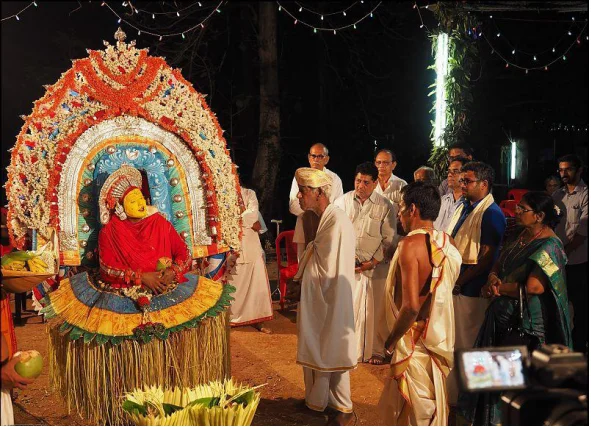
Nudi: Social Justice system of Bhoota Kola
When the Bhoota dance is finished, the invoker gets into discourse with the chief of the village or town. He may inquire as to why the Daiva is summoned. The lines expressed by the invoker now are called Nudi. During the Nudi, the invoker may request to do certain Seva’s for the prosperity of the members of families or may manage the relatives on settling their questions. Additionally, individuals accompany their issues to the Daiva looking for arrangements. The invoker unquestionably guarantees them of the cures. Therefore, Daiva may anticipate that the seeker should do some Seva or gift to the holy place. Like in one case, the invoker requested that the searcher make a silver covering for the sword of Jumadi ( Name of a Daiva), when
his concern gets settled. Individuals then, at that point come to look for the favors of the Daiva. The Bhoota bestows the Daiva’s blessings on the devotees by saying soothing words and giving them Gandha Prasadam (sandalwood tilak and sweets)
Kantara Film & Bootha Kola Controversary
In an interview, the director Rishab Shetty claimed that Bhoota Kola was a component of Hindu tradition. It is a component of Hindu rituals and culture. I am a Hindu, and no one may dispute my belief in my faith or my practises. According to Indian Express, he remarked, “What we have said is through the element that is there in Hindu dharma.
His comments were in response to accusations that Lord Vishnu’s incarnation, Varaha, Panjurli, a ghost worshipped in Bhoota Kola, was represented as such in the movie, according to The Quint. Some people objected to the portrayal of Panjurli as a manifestation of the Hindu god Vishnu and referenced the Sanskrit-language song Varaha Roopam from the film as evidence.
Actor and activist Chetan Ahimsa of Kannada origin entered the discussion and asserted that Bhoota Kola was not a part of Hindu culture. In addition, he claimed that Kantara had “appropriated” Bhoota Kola, an element of Tulu Adivasi culture, according to The Quint.
“Happy that our Kannada movie Kantara is gaining national attention. Bhoota Kola, according to director Rishab Shetty, is “Hindu culture.” False. Vedic-Brahminical Hinduism predates the Bahujan traditions of our Pambada/Nalike/Parawa. We demand that depictions of Moolnivasi cultures, both on and off screen, be accurate.
Before the Hindu religion even got started, Karnataka’s territory has its own culture, custom, and history. Bhoota Kola and other customs have been a part of Adivasi tradition for several thousand years, he continued.
Bootha Kola Festival
Bootha Kola festival or Kola Aata also known as the worship of Daivas or Bhootas or Demi-Gods, is an ancient ritual prevalent among the Tulu speaking community in the Dakshina Kannada districts in Karnataka and in kasargod taluk of kerala,which is collectively referred to as Tulu Nadu. While in Kerala is celebrated as Theyyam.
History of Bhootha Kola
This tradition dates back to 700-800 BC coinciding with the immigration of the Early Tulu tribes who introduced the initial cults of Bermer (also pronounced as ‘Birmer’ or ‘Bermeru’) and Panjurli. Bhuta Kola in Mangalore is a form of spirit dance that is performed by the people of Mangalore from December to January.
Although, the origin of the Bhuta Kola of Mangalore is unknown; yet, Bhuta Kola seems to be an inevitable part of the socio-cultural life of Mangalore. Moreover, the ‘bhutas’ or the spirits worshiped during the festival are believed to be the guardians of the village, who protect the villagers as well as their livestock from the evil forces.
In fact, the spirits that are worshiped by the villagers are considered to be the attendants of Lord Shiva. It is noteworthy in this context that the ‘Kola’ is a kind of Bhuta worship that includes devotion, inspiration and entertainment.
Where to see Kola Fetival?
You can witness Kola festival in the West coastal Karnataka mostly in the rural and sub rural areas. Some of the districts where you can see the Kola festival are mainly Udupi and Mangalore of Karnataka state and Kasargod in Kerala state. This area is also called as Undivided Dakshina Kannada
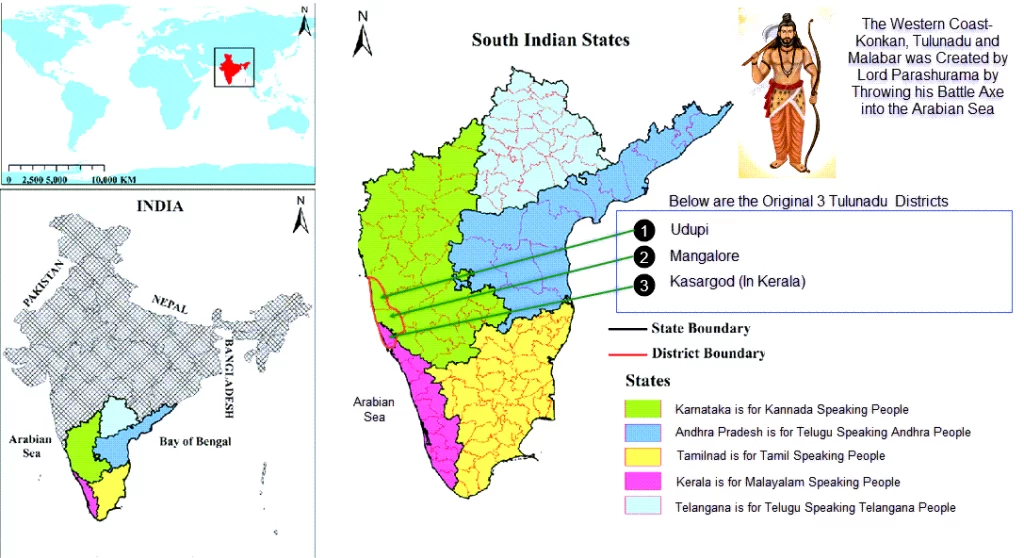
Know where?
Relevance from history
This festival begins in the last phase of Indus valley civilization. By then, there must have been a lot of cultural exchange between other civilizations. Though, Dravidian culture, a flourished culture in India before the Aryans invaded, is talked very less which the Tulu culture is a part of, had found the relevance of the Dravidian language to then North-western Indian subcontinent. The Dravidian language has traces of Iranian and little influenced by the Indo-Aryan language which could have been the cause of cultural exchanges.
Daivas (or) Boothas
Daiva or Bootha refer to a class of supernatural spirits and kola refers to a ceremony for the Bootha, the further understanding is that “a Bootha Kola is performed to appease and solicit assistance from the spirit(s) remaining an ancient ritual of spirit worship.
Such ritual forms of worship remain as ancient practices intended for the blessings of the supernatural. These Daivas are generally kept in the form of idols in the Daivasana (the shrine of the holy spirit ). Some of the prominent Daivas are Jumadi, Jarandaya, Kallurti, Kalkuda, Guliga, and Panjurli.
Daivas are utmost sincere in fulfilling the prayers but at the same time, they should be worshipped and treated with the utmost care and respect. Their wrath is meant to be very dangerous if they get hurt in any way. On the other hand, they will protect and bless the place and people where they are worshipped and honored.
Relevancy of Bhootha Kola with the Ancient World
In an ancient world too, people regarded some of the Gods as being too extreme and strict. However, please the God, on one hand, brought a lot of prosperity and on another hand hurting the sentiments of the God brought calamities.
The above concept could still be seen in modern Indian beliefs. where the planet Saturn is believed in the same way like a careful mother. When the child commits the mistake, he is given punishment but when he is obeying, he gets a lot of love. By then, Vedas and Upanishads had begun taking shapes and the extreme influence of the spirit or the Gods can be referred from theirs.
Relevancy of Bhootha Kola with the Dravidian Culture
Still, in some of the temples in South India, women or even other caste people are not allowed to enter the temple or attend the sacred events. In some places around Mangalore only four Daivas: Kalushti (female), Kalkudae (Male) Guligae (Male) and Panjoli (Female) are worshiped. Where Kalushthi and kaludayi acts as sister-brother and the same applies to guligayi and panjoli. These duos are meant to be siblings.
In the first-half Kalushti and kalkudae come and play their part and the second is played by Guligay-Panjoli helped. It is Believed did falling on Kola worship the real Daiva’s Spirit comes into the person performing it and They predict and can forsee the future. They are worshiped with utmost respect and dignity.
Daivas are bit different from the gods we worship since They Are utmost sincere in fulfilling the prayers but at the same time they will be worshiped and shoulder stand Treated with the utmost care and respect. Their wrath is meant to be very dangerous if They get hurt in any way. On the other hand, they will protect and bless the place and people are worshiped and honored where they.
Relevancy of Bhootha Kola with other Cultures
I find this tradition in relevance with other peaceful cultures of Africa where the concept of community is held high. Apart from community gathering, there are other things which are in common like dancing around the fire in winter, dressing as tribal folks, believing in ancestors and spirits and being very sacred and aesthetic about the ceremony.
Influence of local culture on Bhootha Kola Festival
Most of the sacred celebrations or the worshipping over the years get influenced by the local culture, habitat, flora and fauna. If marked properly, The dressing of the Daivas has more been influenced by the grandiosity of the Gods in South India. However, on the other hand, some parts of the South India has also been known for worshipping demons and it can be seen that one of the Daivas is dressed up as a demon.
Relevancy to Hindu Mythology in the Celebration
In the picture above, the guy in the left has Trishul (Three-in-one spear) in his hand which is the main weapon of lord Shiva. While the guy in the right is dressed up as some goddess from South India. Another relevancy is the colour of the face of another Guy in the picture below.
The above in the picture has his face painted almost blue which might represent the color of lord Shiva and there must be some relevancy between the Gods and demons as lord Shiva is known to be the God of the ghosts, demons and all.
Scientific Reason After the Food Served
The food in the picture below seemed to be apt for the performers. After dancing around the fire in heavy get-up, coconut water is the perfect drink to replace ions and salt in the body while raw coconut acts as a source of energy for the time being.
Palm Leaves
Available in abundance, palm leaves are used as a skirt and green leaves being easy-flammable helps the performers to prolong the play around the fire.
Kola and Nema: The Distinction
In traditional Tulunadu, the recurrent Spirit worshiping festivals are popularly known and celebrated either as Kola or Nema.
Kola and Nema
The term Kola appears to be a heritage word that has been brought along with early cycles of human immigrants to our land. The ancient word Kola possibly of African origin means an agreement or convention mutually agreed upon.
The term Nema appears to be an equivalent of the word “Niyama” commonly found in many of the Indian languages including Sanskrit. Thus literally the Nema (or Niyama) means a rule or a convention to be followed).
There is a fine distinction between a Kola and a Nema celebrations that can be summarized as follows:
In the case of Nema Celebrations:
1. There is hoisting and lowering of Kodi (flag) to mark the commencement and culmination of the annual ceremony. This aspect is similar to the convention of flag hoisting and lowering followed up by temples in the region during the annual festivals in the temples. Duration of Kodi until the Nema will be around 40 days as per my knowledge. People who came from other town/villages during the Kodi are not suppose to leave the village until the Nema is over. But if they go for some urgent work, they must come back on the day of Nema or take the permission from the priest by taking some Gandha Prasada and putting some kanike to the Bhandara(Hundi). Tulunadu people will believe these rituals and follow them strictly.
2. Besides, there is ‘Bandi-Bali’ consisting of circum-ambulation by the impersonator sitting in a decorated wooden car/cart-cum-horses, around the Bhuta Sthana (Spirit Shrine), the cart being drawn by devotees. In some cases, Bhuta’s mask or idol is seated in the Bandi or the wooden car. Such annual festival is also called as ‘Bandi Nema’.
3. All other Bhuta festivals are called ‘Kola’.
List of Tulunadu Daivas
1. Dhumavati/Jumadi Bunta – One of the most popular Daiva of Tulunadu
2. Pancha Jumadi Bunta
3. Marl Jumadi
4. Kaanteri Jumadi
5. Kolatha Jumadi
6. Kolla Pootha Jumadi
7. Mardal Jumadi
8. Panjurli – This can be seen in Kanthara Movie and is very popular in Tulunadu. Many types of Panjurli Bhutha’s can be seen below.
9. Annappa Panjurli
10. Kallurti-Panjurli – This duo is also One of the most popular Daiva’s of Tulunadu
11. Kuppettu Panjurli
12. Baggu Panjurli
13. Golidadi Panjurli
14. Kalyaboodu Panjurli
15. Dendoora Panjurli
16. Paajei Panjurli
17. Kadambare Panjurli
18. Jodu Panjurli
19. Male Panjurli
20. Guliga Panjurli
21. Varna Panjurli
22. Alera Panjurli
23. Malara Panjurli
24. Bollela Panjurli
25. Tembailu Panjurli
26. Chombakallu Panjurli
27. Kaanthavara Panjurli
28. Hebri Panjurli
29. Kukke Panjurli
30. Kadri Panjurli
31. kadapu Panjurli
32. Ambadadi Panjurli
33. potta Panjurli
34. Kadambare Panjurli
35. Guliga Panjurli
36. Kalkuda-Kallurti
37. Odilthaye
38. Pilichamundi/Vyagra chamundi
39. Bobbarya – Popular in Kundapura, Barkur in Udupi Distc
40. Jaarandaya
41. Kodamanithaya
42. Kukkinanthaya
43. Baikadthi
44. Chikkamma
45. Daaram Ballalthi
46. Kalabhairava
47. Kalarahu
48. Kaalarkai
49. Kumara Swamy
50. Kanyakumari
51. Mahakali
52. Paatala Bhairava
53. Mayandal
54. Malaraya
55. Koteda Babbu Swamy
56. Tannimaniga
57. Chavundi
58. Guliga
59. Sankale guliga
60. Subbiyamma Subbi Guliga
61. Guliga bhairava
62. Raudrandi guliga
63. Rahu and Guliga – This duo is also One of the most popular Daiva’s of Tulunadu. Every Tharavad House(Guttu House) has Guliga and Naga Kallu (Stone) to worship.
64. Netther Guliga
65. Paatala Guliga
66. Neecha (Koraga Taniya)
67. Kamberlu
68. Abbaga Daaraga
69. Kshetra Paala
70. Nandigona
71. Maisayndaya
72. Rakteshwari/Lekkesiri
73. Raahu
74. Jattiga
75. Naga Bermer – Most popular in my village Kodikal, Mangalore.
76. Kaalamma
77. Kanapadithaya
78. Kuriyodithaya
79. Kallerithaya
80. Dayyengul
81. Ullalthi
82. Moovar daivangal
83. Naalkatthaya
84. Satyadevate/Posa bhuta
85. Mantradevate
86. Bunta Daiva
87. vaidyanatha/ mundathaya
88. Ajji Bhuta
89. Shiradi Daiva
90. Koragajja – One of the very powerful and popular Tulunadu Daiva. Even Muslims are very big believer of Swami Koragajja
91. Korati Amma – My Tharavad community’s main Daiva and is our family Daiva. Refer https://mangiillam.com to know more about Mangi Illam Tharavad.
92. Poyyathai
93. Hallathayi
94. Koti Chennaya– Legendry Heroes of Tulunadu
95. Bhavana
96. Vishnumurthy
97. Birnachari
98. Padkanthaya
99. Brahma Mugera
100. Uliyathaya
101. Pattorithaya
102. Muttappa Daiva – Most Popular in Kasargod, Kerala.
